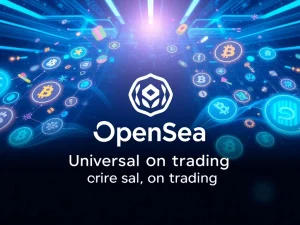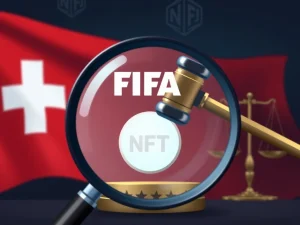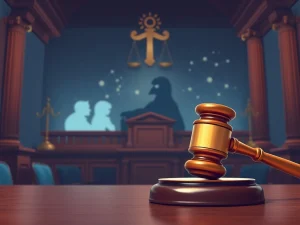Unlocking Immense Value: Digital Ownership Powers the Future Economy

For anyone in the crypto space, the question often arises: how can something purely digital have real value? Cryptographic tokens, whether fungible like cryptocurrencies or non-fungible like NFTs, exist only in the virtual realm. They aren’t physical objects, nor are they typically backed by traditional institutions in the way fiat currency might be. Yet, understanding their value is crucial, especially when considering the potential of the open metaverse – a decentralized internet built on true digital ownership.
The Enduring Power of Intangible Assets
The concept of value residing in the intangible is not new. History shows that ownership of non-physical things has driven innovation and economic growth for centuries. The key lies in the rights and benefits associated with that ownership.
How Intellectual Property Shaped the Modern World
Consider the foundation of modern innovation-based economies: intellectual property (IP). A pivotal moment occurred over 300 years ago in Great Britain with the Statute of Anne (1709/1710). This act established the author, not the publisher, as the rightful owner of printed works. By granting creators exclusive rights for a limited time, it created an economic framework:
- Creators gained control and financial incentives.
- Society accessed works through distribution channels.
This distinction between creator and distributor mirrors today’s relationship between artists and digital platforms. The Statute of Anne fueled explosions in literature, science, and philosophy during the Enlightenment and Scientific Revolution, bringing fame and independence to innovators. It provided economic incentive, ensuring contributions endured. The power of this model led other nations, like the United States (Copyright Act of 1790), to follow suit.
A notable modern example is China. Once known for IP infringement, its strengthening of IP protection in the 1990s and early 2000s coincided with a significant rise in domestic innovation, measured by patent applications.
Recognizing Ownership of the Mind’s Work
Today, we widely accept that intellectual property, though intangible and time-bound, is subject to ownership. Copyright, trademarks, and patents protect these creations. Philosopher John Locke’s idea that a person owns the labor of their body and hands provided a basis for this, extending to the intangible products of the mind.
IP protection is vital in capitalist economies. It incentivizes creators and makes commercial success possible for mental works. Without it, industries like technology, science, and medicine would suffer from a lack of R&D incentives. The Statute of Anne fundamentally changed the world by creating a framework for owning and protecting the work of minds, enabling intangible capital assets and fueling wealth generation. Crucially, it decentralized power from publishers, granting rights directly to creators. This understanding of intangible value is core to entities like Animoca Brands, whose mission centers on advancing digital ownership rights.
The Economic Might of Assets Without Physical Form
Traditional business recognizes intangible value in brand equity, goodwill, and IP. Even the data we generate online is highly valued. Intangibles dominate the global economy:
- In 2019, IP-intensive industries contributed 41% of US economic activity and supported 44% of US employment (USPTO estimate).
- In 2023, intangible assets were valued at $62 trillion, significantly exceeding the market cap of gold (WIPO estimate).
Given this immense economic power, suggestions to abolish IP law seem counterproductive, ignoring centuries of successful innovation and development.
Blockchain Technology: Enabling Provable Digital Ownership
This is where blockchain technology becomes a game-changer. It provides provable ownership, scarcity, and economic opportunities for intangible assets in a decentralized, cost-effective, fast, and secure manner. Traditionally, asset ownership records rely on centralized authorities, facing issues like security risks, access barriers, inefficiency, high costs, and red tape. Blockchain’s decentralized, immutable ledgers reduce waste, vulnerability, and loss, automating record-keeping more efficiently and securely.
Artificial Minds and Intellectual Property Challenges
The current AI revolution highlights the critical nature of IP-based value creation. AI training often uses protected IP, raising concerns about imitation’s impact on rights holders. Industries are grappling with questions:
- Should AI developers be able to use copyrighted material for training?
- How should creators (like actors whose likeness is used) be compensated for AI-generated works based on their IP?
These complex issues require solutions. Blockchain technology offers a framework for tracking provenance, ownership, and usage of IP challenged by generative AIs. It can facilitate usage tracking and royalty payments for individual assets, even those of low value, providing fair rewards and accreditation to creators whose IP fuels AI.
Digital Property Rights: The Next Frontier of Ownership
When asked about the value of NFTs or cryptocurrencies, comparing them to traditional creative works helps. Just as we appreciate IP rights for music, books, or films, we can understand the value of virtual objects, which often represent or link to intellectual property. Whether it’s an idea, a written work, digital currency, or an NFT, ownership is key. Ownership confers opportunities not possible without it.
As the world goes increasingly digital, the mission to make digital ownership rights available to all is more relevant than ever. This ensures creators are rewarded for their work and contributions, even those used by AIs or platforms. The same principle of intangible ownership that fueled historical revolutions can now extend to our digital lives in the decentralized open metaverse. Here, technological frameworks inherently enshrine provable virtual ownership, making asset creation and access democratic and available to all participants.
Conclusion: A Future Powered by Digital Assets
Over 315 years after the Statute of Anne laid the groundwork, the convergence of technology and property rights is set to unleash significant creativity, economic empowerment, and progress for billions. Understanding and embracing the value and ownership of the intangible, facilitated by blockchain technology, is not just about cryptocurrencies or NFTs; it’s about recognizing the fundamental drivers of value in the digital age and building a future where creators and participants are fairly rewarded in the burgeoning metaverse.









